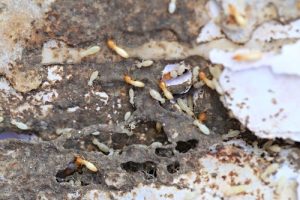
Myrtle Beach termites might be tiny, but they can cause big problems for homeowners. Being able to spot these pesky insects is crucial to protect your home from potential damage. Let’s dive into how to identify termites and distinguish them from similar-looking bugs, ensuring your home stays termite-free.
Chapter 1: What Do Myrtle Beach Termites Look Like?
Termites are small, measuring anywhere from one-eighth to one inch in length. They come in various colors: brown, black, or white, depending on their species and role within their colony.
All termites share some common traits, like six legs, two straight antennae, and soft, segmented bodies. In the United States, there are over 40 termite species, but the most common types are subterranean, dampwood, and drywood.
Chapter 2: Subterranean Termites
A subterranean termite is often pale cream to dark brown or black. They live underground and need moisture to survive. You may not see them, but you might notice mud tubes they build to move from the ground into your home. Here are their different castes:
Workers: Soft, pale bodies; responsible for finding food, caring for larvae, and nest maintenance.
Soldiers: Larger, darker heads with big mandibles used for defense.
Reproductive Termites: Include kings, queens, and alates. Kings and queens are larger, while alates have wings to start new colonies.
Chapter 3: Damp wood Termites
A damp wood termite is a large termite in Myrtle Beach but have smaller colonies. They nest in damp wood, including rotting timber, and have various colors. Notable members include:
Workers: Larger than subterranean workers with cream-colored bodies.
Soldiers: Impressive in size, with large flat heads and fierce mandibles.
Alates: Easily distinguishable by their two pairs of wings of equal size and shape.
 Chapter 4: Dry wood Termites
Chapter 4: Dry wood Termites
A dry wood termite, found in humid coastal areas, doesn’t require soil or mud tubes. They obtain moisture from the air or the wood they inhabit. Their colonies are smaller, and they live within the wood. Look out for:
Workers: Cream to white in color, similar to subterranean workers.
Soldiers: Larger than their subterranean counterparts, with dark orangish-brown heads.
Alates: Recognizable by amber-colored heads, dark brown abdomens, and smoky gray wings.
Chapter 5: Signs of Termite Activity
Seeing termites is rare, even with an infestation. Instead, watch for signs such as discarded wings, mud tubes outside your home, or piles of termite feces (frass) near tiny holes. If you notice these indicators, it’s time to seek professional termite treatment in Myrtle Beach.
Chapter 6: Termites vs. Ants
People often confuse Myrtle Beach termites with ants, especially during swarming events. To differentiate, remember that ants have bent antennae, two sets of wings of different lengths, and three distinct body segments. Myrtle Beach termites have straight antennae, two sets of equal-length wings, and less distinct body segments.
Chapter 7: Taking Action
If you suspect a termite infestation, don’t delay. Contact pest control professionals in Myrtle Beach to assess and address the issue promptly. Protect your home from these tiny but troublesome invaders.
Don’t let termites bug you! Keep your home safe by staying vigilant and seeking professional help at the first sign of trouble. Call Zap Pest Control Inc. now.
Zap Pest Control Inc.
2507 Forestbrook Rd Suite G
Myrtle Beach, SC 29588
843-654-1927
http://zappests.net
Areas Served: Surfside Beach SC, Carolina Forest SC, Conway SC, Little River SC, North Myrtle Beach SC, Socastee SC, Myrtle Beach SC

No comments:
Post a Comment